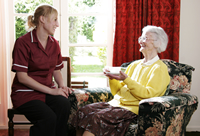Taking a Break from Caregiving

 Respite care lets you take a break from caregiving. It may be for a few hours or several days or weeks. Respite care may be provided in the home. Adult day care centers, assisted living centers and nursing homes may also provide respite care.
Respite care lets you take a break from caregiving. It may be for a few hours or several days or weeks. Respite care may be provided in the home. Adult day care centers, assisted living centers and nursing homes may also provide respite care.
Why Is It Important?
Respite care gives you a chance to take care of yourself. It allows you time to take a vacation, shop or visit friends. Taking care of your own needs will help you be a better caregiver. It can help keep your loved one at home after a stroke.
What Do You Need to Know?
Include your loved one in planning for respite care – Decide together what help you need. Ask your loved one about having help from others. Would your loved one be comfortable for a short time staying in a care facility?
Include other family members in the planning – Give them information. Let everyone express their concerns. Give everyone a chance to help.
Make a plan for your loved one’s future – Plan for emergencies before you need help.
Create a care team to help with your loved one’s needs – The team may include professionals hired to help. Use volunteers, family, friends, neighbors and church members.
Where Can You Get Help?
- Talk with the social worker at your local VA medical center. Each VA has different types of respite care.
- Think about using a geriatric care manager. Geriatric care managers are specialists who plan and manage care for older people. They can assess your loved one’s needs. They can arrange for services. Some charge a fee. Contact the National Association of Professional Geriatric Care Managers.
- Clergy, staff in senior centers and local organizations can help.
- Your local Area Agency on Aging can also help. Find your Area Agency on Aging through the Eldercare Locator.
How Can You Pay for Respite Care?
- The VA may provide free respite care for up to 30 days in a year or more. Contact the social worker in your local VA medical center. The social worker will know if your loved one is eligible for respite care.
- Some VAs provide free respite care in the Veterans home, in the VA nursing home or in non-VA community centers.
- Some private insurance companies pay for respite care.
- Medicare or Medicaid may pay for respite care.
- You may find other ways to pay for respite care where you live. Check with your local Area Agency on Aging.
Helpful Tips
- Ask for and accept help. Accepting help can improve everyone’s quality of life.
- Screen people before hiring them. Check at least two references before hiring anyone not from an agency. The Family Caregiver Alliance has a “Hiring In-Home Help” fact sheet. Find the link to the fact sheet in the Resources section.
Remember
- Respite care can give you a much needed break from caregiving.
- Check with the social worker at your local VA medical center. A number of local VA and community resources are available.
- Plan for respite care before you need it.
More Resources 
Additional credible resources on this topic can be found here. Website pages may change or update, therefore if a link does not work, you may also try to type the information into your internet search bar. This Resource List will be updated frequently.
|
*Link Disclaimer: Links to information and Web sites outside of the Department of Veterans Affairs do not indicate an endorsement of products or services offered by the sites. In addition, these sites may have privacy and security policies that are inconsistent with those of VA. |
References: Family Caregiver Alliance. (2008). Retrieved July 23, 2008, from: https://www.caregiver.org/resource/respite-tips-taking-break-giving-care-someone-need/*, Houts, P.S. (Ed.). (2004). Eldercare at home. (2nd Ed.). New York, New York: The American Geriatric Society for Health in Aging; Connecting for Care. (2008). Retrieved September 23, 2008, from: http://www.connectingforcare.com; National Family Caregivers Association. (2008). Retrieved June 27, 2008, from: http://www.nfcacares.org/pdfs/ReachOut.pdf (This resource is no longer available.)
These materials were created for the project:
Web-Based Informational Materials for Caregivers of Veterans Post-Stroke
Project Number SDP 06-327 funded by VA HSR&D Quality Enhancement Research Initiative (QUERI)



















